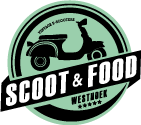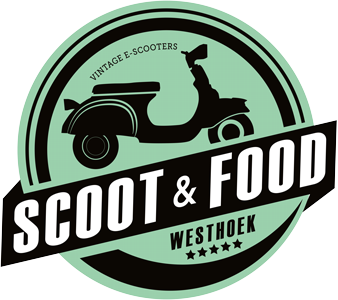Scooter, helmet, sunglasses and go !!!!
We leave for the Kastanjeplein, the west side is marked by the Belgian observation tower from the First World War. From here the observers could observe enemy artillery, troop movements and construction of new fortresses and transmit the observations to their own artillery. In the Second World War, the tower was put back into use by the German occupier. They built a brick machine gun nest on top of the observation tower.
Via the Sint-Katharina Kapellepad we drive to Rousdamme. In the meantime, enjoy the beautiful flat polder landscape to the full. Be careful we cross the Rousdammestraat and now follow the Oude-Aa -vaartpad. We skilfully overcome the obstacles, over the bridge, underneath the bridge. We are now in a unique polder landscape, namely the extensive protected basin grounds of Lampernisse. Hear the silence, see the charm of the beautiful historic polder grasslands. We drive on over the monumental brick arch bridge (the Paardenbrug), over the Grote IJzerdijk to Fortem. There we can look for the malt & brewhouse “De Snoeck”. The Museum of Thirst !! Visit to the brewery and malt house from the 19 the century is possible with reservation. In the museum inn, visitors can choose from more than 150 regional beers to taste.
We take the towpath next to the Lovaart and scooter to Oeren. In “De Leute”, a popular tavern, you can relax in a relaxed atmosphere enjoy the atmosphere of a farmhouse or a nostalgic beer. Do you prefer it more authentic? Drive a little bit further to Christel from “Over Vlees”. Here you can have a coffee in peace and enjoy the outdoor life. En passant you pass the former Saint Apollonia Church, a slender stone needle crowns the square tower and it is popularly said that churches with a stone needle should serve as orientation for the fishermen along our coasts. For example, the church tower of Oeren, when the sun shines on it, can be seen very far out into the sea. The Belgian military cemetery, which is located around the Saint Apollonia Church, was protected as a monument in 2008.
We cycle freely, cheerfully and relaxed further to the picturesque village “Beauvoorde” with its enchanting castle. A guided visit to the castle not only offers us a unique insight into the romantic world of the eccentric nobleman Arthur Merghelijnck, but also presents a wealth of 17 the – Exhibition of century furniture, paintings and household goods. Perhaps the cozy mysterious coffee-tea house “Toe Tuzend”, where Olleman is welcome, is already open.
Cheerful and full of joy we scoot through this charming part of Westhoek “aka Bachten de Kupe”. The green meadows with grazing cows, a farm and a church tower in the distance give us a nostalgic feeling. At most, the peace is interrupted by a tugging tractor. Enjoy !!!! This is how we enter Leisele, the unique village center has been a protected village view since 1996 and is located near the French border. Here hangs an incredibly calm, casual, French atmosphere in the air. Enjoy it to the fullest…., Breathe in and out… ..And off scootering, on to Hondschoote, a municipality in the French department of Nord, in French Flanders and the French Westhoek. The pronunciation in French sounds like onsjot or ons kot. Hondschoote is not a big city, but has an imposing and impressive church. Eglise Saint-Vaast located on the Place Du General De Gaulle. It is a brick Gothic hall church with an 82 m high tower (called the White Torre) built in white bricks. This church has a curious high stone spire. On the plaetse (market place) you will also find Hotel de Ville (Mairie d’Hondschoote). This is the oldest town hall in the area. Voila. We continue our way and drive over the “schreve” to Houtem, a quiet agricultural village, which is on the list of the 50 most beautiful villages in Flanders. Quench the “thirsty”? It is possible, in a small pleasure !! After this work of mercy, we now drive into the Moeren, an excellent terrain for smugglers for years. The “Blues” were engaged in the bluing (smuggling) of spirits and tobacco. Through wind and weather and at night and at night, the customs officers (the committees) went there on foot or by bicycle out to catch the “bluers” in the collar. The customs shelters offered a welcome relief to the officials of Customs and Excise. The commiezenkotje (shelter) on the corner of W.Coberghestraat and Noordmoerstraat is the last remaining shelter of the three that were built at the time. A unique remnant from a time when there were still borders. Want to enjoy another heavenly ice cream? Then stop for a while at the farm St-Flavie to taste their artisan ice creams. And now just give “buzze”… to Steenkerke and from there to Eggewaartskapelle. Via the Molenpad we arrive in the village of Avekapelle with its Oude Zeedijkmolen. Here we follow the rural field road, away from the beaten track. Be careful! We do have to cross the Veurnestraat. We drive smoothly via the picturesque bridge over the proostdijk canal to the atmospheric polder village Booitshoeke. Take one last photo of the mosaic colored cobblestone carpet in front of the special church. Now, the last final sprint to ‘t Antoontje on the Sint-Antoniushoeve.
Settle in, taste our homemade picon and enjoy this incredible day.
ps : ps : we do not recommend day trips for young people less than 6 years old.


